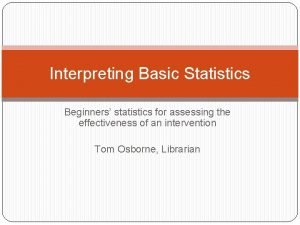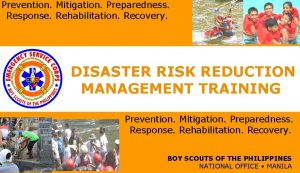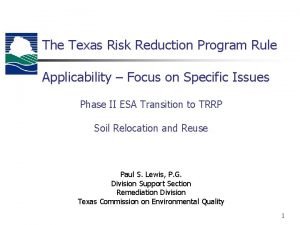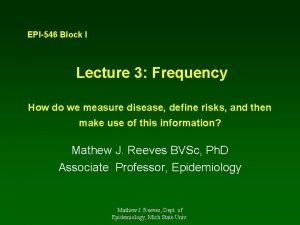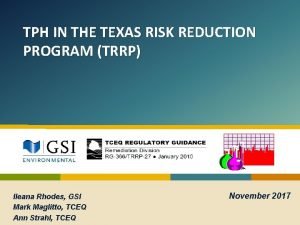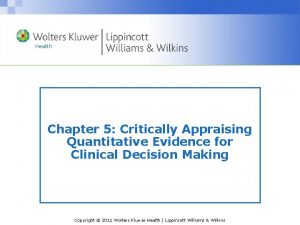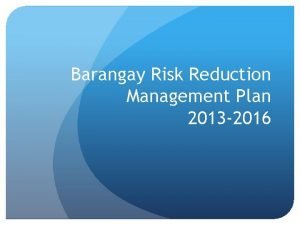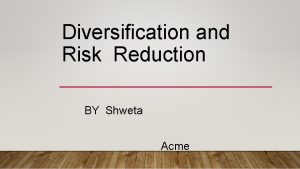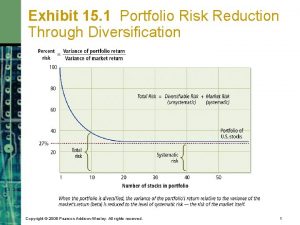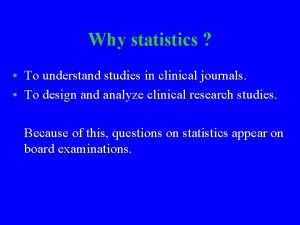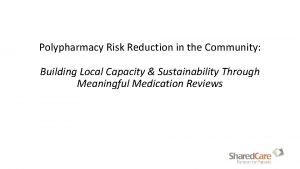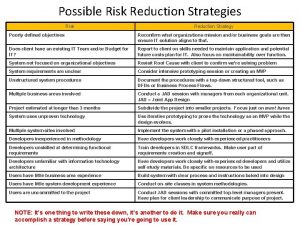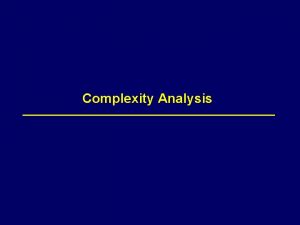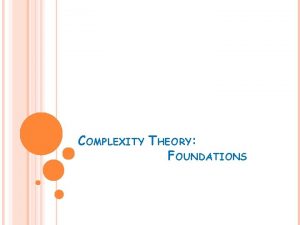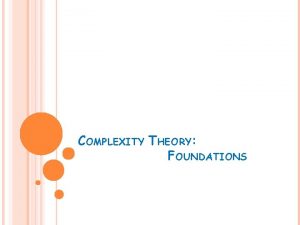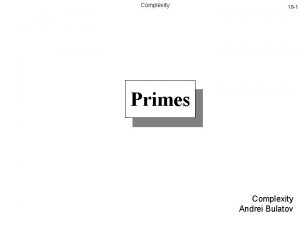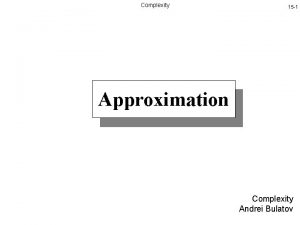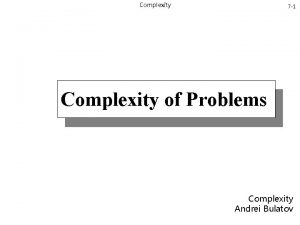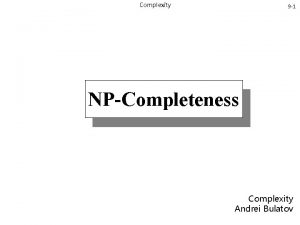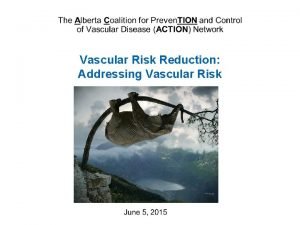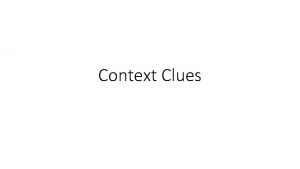Polypharmacy Risk Reduction in the Context of Complexity

























































- Slides: 57

Polypharmacy Risk Reduction in the Context of Complexity, Frailty and End of Life TORCH Education Program Victoria, BC Feb 14, 2015 Dr. Chris Rauscher

2

Objectives/Focus w Understand the basics of Polypharmacy Risk Reduction (PRR)-What, Why w Understand moving from a focus on decisions about medications in general to making clinical decisions in the context of resident complexity, frailty and end of life as an intro to today’s session w Disclaimer- no conflicts of interest, although I am getting paid to be here as the Clinical Lead for the Shared Care PPh initiative 3

What Exactly is Polypharmacy? 4

What exactly is polypharmacy? w If not defined by number of medications, then: w Clinically indicated: proven benefit or benefit>harm w (Clinically) Warranted- Justification for an action or a belief Bring in patient/resident/family perspective w Polypharmacy Risk Reduction w More than looking at individual drugs or drug classes-Balance w More than stopping meds w Starting meds w Reducing dose w What is ‘appropriate’ for this resident? 5

Why is Polypharmacy Important? 6

w There is No Magic Number To Define Polypharmacy But Adverse Events Increase as Meds Increase w Likelihood of an ADE w w w 7 2 pills. . . . . 13% 5 pills. . . . . 58% 7 or more………………………. . 82%

Adverse Drug Events w ‘Events’: Falls, Delirium w Side effects (Versus ‘Drug Reactions’) w Interactions w Drug-Drug w Drug-Disease w Drug-Nutrition

Adverse Drug Events (ADE’s) w Acute care Admissions w Elderly - 16% of all admissions (27 -40% preventable) w Younger- 4% of admissions (20% preventable) J Am Geriatr Soc. 2002 Dec; 50(12): 1962 -8. BMJ 2004 Jul 3; 329(7456): 15 -9 ; JAMA 1998 Apr 15; 279(15): 1200 -5. ; Pharm World Sci. 2002 Apr; 24(2): 46 -54. w Residential Care w 10% of LTC population/month have ADE w (Gurwitz: Am J Med. 2005 Mar; 118(3): 251 -8. ) w 40% preventable

Common Side Effects For Meds Decreased general health Increased risk of falls and hip fracture Decreased cognitive function 10 w Fatigue, weakness, muscle aches w Anorexia, nausea, bloating, cramps, constipation, diarrhea w Dizziness, postural instability, orthostatic hypotension , hypoglycemia w Confusion, sedation, headaches, insomnia, restlessness, agitation, delirium

My belief: Accumulation of minor side effects = people could feel crappy! Affecting their function and quality of life! 11

Polypharmacy is a stand-alone risk factor for morbidity and mortality Even when we control for other comorbidities and specific drug effects.

Hospitalisation-Associated Disability Hospitalization is a sentinel event that often precipitates disability. This results in the subsequent inability to live independently and complete basic activities of daily living (ADLs). This hospitalization-associated disability occurs in approximately one-third of patients older than 70 years of age and may be triggered even when the illness that necessitated the hospitalization is successfully treated. 13

The Challenge w Average number of regular medications per LTC resident in BC is around 9 (range 0 -55!). Anecdotally, 12 -14 not uncommon. w With careful practice, this number can be 5 -6 w RAI-MDS counts number of residents on >9 regular meds, and this is often above 50% w What is your site’s RAI-MDS data?

What are the Causal Factors Leading to Polypharmacy? 15

What are the causal factors leading to Polypharmacy? Wrong Context: Single Disease-Shift to Complex, Multimorbidity, Frailty, End of Life • Clinical Practice Guidelines (Chronic Disease Management) Ø Multiple prescribers Ø Treating surrogate markers Ø Clinical uncertainty § ADE or new symptom? -Drug cascade Ø Uncertain treatment goals Ø

What are the causal factors leading to Polypharmacy? Clinical and system complexity • Ø Ø 17 Difficulty getting the history Inadequate communication Collaborative and Shared Care challenges Challenges of involving resident/family

What are the barriers to effective Medication Decision-Making?

What are the Barriers to Effective Medication Decision-Making? w Consensus on clinical/pharmacological knowledge, especially with complexity of resident population w Perceived Medico-legal Risks w Process and communication issues w Absentee MRPs w Other care priorities, time, remuneration. w Family and Resident Involvement

Supportive Initiatives: Community • Professional Academic Detailing in GP offices - Medication knowledge • Polypharmacy RR - Medication review • TORCH • GPSC Res Care • Physicians Data Collaborative • CIHI Data Project • Tools-ADAPT, Med Stopper. an re Ca Tr in sit ion in ion sit Ca re an Tr Patient Residential Care Hospital • Med. Rec - Best possible medication history • 48/6 - Assess 6 areas w/in 48 hr • Polypharmacy RR - Medication review Best possible medication Transition in Care • CLe. AR - Appropriate antipsychotic use • Polypharmacy RR - Medication review

What Will Help You To Make Effective Decisions About Medications?

Evidence-Based Approach

What about in Residential Care ? w Garfinkel, Zur-Gil, Ben-Israel; IMAJ (Vol 9), June 2007 w 190 patients in 6 geriatric nursing departments on 7. 09 regular meds/pt. w 119 pts; after careful review, 2. 8 regular meds/pt stopped (4. 3 meds/pt) w 71 pts in control group on same wards with same doctors, with meds unchanged, studied for one year.

Results w No significant adverse events w 1 in 10 drugs eventually needed to be restarted w One year mortality rate was 45% in controls and 21% in the study group (P<0. 001) w Annual referral rate to acute care was 30% in controls and 11. 8% in the study group (P<0. 002)

Evidence-Based Approach and Tools

What Approaches/Tools w Beers Criteria; STOPP/START: Mix of specific drug/drug classes of concern plus specific drug interactions w Too many variables to remember/work with unless have an electronic system w Our approach- Specific drug/drug classes of concern 26

27 Drug Decision Algorithm Adapts Garfinkel (2010) – evidence, risks, indications, etc.

Priority De- Prescribing Drug List: Lower Doses, Trial Discontinuation w Drugs associated with w Confusional States w antipsychotics, antidepressants, opioid analgesics, hypnotics, digoxin w Adverse Drug Event-related Falls w antipsychotics, antidepressants (tricyclics), hypnotics, antihypertensives, hypoglycemics, anticonvulsants, antiparkinson meds, antihistamines w Significant Anticholinergic Effects w antidepressants (tricyclics), antihistamines, bladder meds w Bleeding w warfarin, antiplatelet meds

Priority De- Prescribing Drug List: Lower Doses, Trial Discontinuation w Indications no longer present-Symptom Control w PPIs, analgesics, antianginals, antipsychotics, antidepressants w Indications not present-Preventative w Statins, osteoporosis meds, antihypertensives 29

Supports For Drug Review Decisions w Guide individualized consideration of patient-at-hand w Drug Advisory Sheets [drafts] + One-page: “You Decide”** PPIs ANTIPSYCHOTICS STATINS HYPNOTICS ANTIHYPERTENSIVES ANTIDEPRESSANTS BISPHONATES VITAMIN D & CALCIUM SUPPLEMENTS w Drug Brief: Calcium w Understanding of clinical condition w Condition Advisory Sheets STROKE PREVENTION IN THE ELDERLY (DRAFT) DEPRESSION IN THE ELDERLY (DRAFT) TREATING DIABETES IN THE FRAIL ELDERLY (FORTHCOMING) Materials are aligned with GPAC and OPUS materials – and will be reviewed by a Clinical Advisory Team

What Statistical Tools Will Help With Clinical Decision-Making?

Stats w Distinguish by drugs for symptom control versus drugs for preventing a future event w Event rates- The proportion of patients in a group in whom the event is observed w NOT Relative Risk Reduction- Used to compare the risk of an event happening in two different groups of people w Absolute Risk Reduction- Risk of developing an event over a time period w Number Needed To Treat (NNT)/Number Needed To Harm (NNH) 32

Stats w Time to Benefit (TTB)/Time to Harm (TTH) w Time to Lose Benefit (TLB)/Time to Reduce Harm (TRH) w Statistical benefit vs clinical benefit (harm) 33

Number Needed To Treat-NNT www. thennt. com w Estimating the number of patients that need to be treated in order to have an impact on one person. w The concept is statistical, but intuitive, for we know that not everyone is helped by a medicine or intervention — some benefit, some are harmed, and some are unaffected. The NNT tells us how many of each. Addressing Polypharmacy

Deaths reduced 10% to 8%= 2% Absolute Risk Reduction RRT (relative risk reduction)= 2%/10%=20% NNT= 1/ARR=1/2=100/2=50=Treat 50, avoid 1 death NNH-2% Additional Bleeds, Treat 50, 1 bleeds Addressing Polypharmacy

Statins- Before ‘You Decide’ w Discontinue if for primary prevention; if for secondary prevention, apply risk-benefit analysis and continue treatment only for demonstrated significant vascular risk: past MI/stroke 36

37

Statins- ‘You Decide’ w Harms- Major Uncommon: w Asymptomatic liver enzyme elevations by 0. 4%; Rhabdomyalysis: ? w Risk of type 2 diabetes by 0. 5%, in ‘pre-disposed’, < CV risk in many people w Memory loss/’confusion’-? w Harms- ‘Minor’ side effects w Muscle-related symptoms-10 -50%? , residents cumulative causes aches and pains w Nausea, gas, diarrhea or constipation 38

Statins- ‘You Decide’ w Review the use of a statin in the residential care environment in the context of life expectancy and goals of care, as well as from the perspective of the potential aggregation of adverse effects from multiple meds that may affect mobility/function and quality of life. Is the benefit greater than the potential harm? 39

PPIs- You Decide w Symptomatic control- Stats not as helpful: PPIs somewhat more effective than H 2 RA w Many patients are on long term PPIs without clear ongoing indication/benefit, and the more drugs, the more potential for side effects/adverse events and time taken to administer: w For GERD- Use 4 -8 weeks then trial discontinuation w May have been started for ‘stress ulcers’ in hospital but can stop when discharged, unless major ongoing bleeding risk 40

Moving From Focus on Single Drugs/Drug Classes to Whole Drug Profile In Complex Residents

Fraser Health Guide To Person-Centered Medication Decisions

w Starts with your own goals (beliefs, values)- for meds: w only those ‘warranted’, quality of life (active symptoms), function w Management- Not always or only with meds: nonpharmacologic approaches- pain, constipation, mild depression, BPSD etc. 43

w Utilize Comprehensive Geriatric Assessment and (Repeatedly) Communicate Prognosis with patients families and community workers 44

w Estimate Remaining Lifespan- Life-limiting conditions w Interested in prognosis, trajectory of decline to set context for goals of care and decision-making w In most will be dementia as an end of life condition (Dr. Rosenberg: ‘Palliation for Advanced Dementia’ w In some may (also) be chronic-exacerbating conditions. CHF, COPD, neurologic-Parkinson’s, MS etc. w ‘Surprise question’- ‘would you be surprised if this person is still alive in 6 months’: Frailty, triggersreduced nutritional intake, febrile illness, pneumonia, repeat ‘exacerbations’, progressive CRF, low BP, low Na 45

Use of Medications of Questionable Benefit in Advanced Dementia Tjia et al JAMA Int. Medicine Sep. 8 th 2014 w N= 5406 nursing home residents with advanced dementia (MMSE-5) w 54% were on medications with questionable benefit w 22. 4% statin drugs w Lower likelihood w Not having an Eating problem w DNR w Enrollment in Hospice w 35% of all medication expenditures were for medications of questionable benefit w Cost $553/$816/90 days

w Determine what impacts quality of life and function w This will usually be the main focus of the care plan w May be ‘hidden’ and require Tx (not always or only with drugs)- pain, constipation, depression w BPSD with Dementia (http: //www. bcbpsd. ca) w Current w Potential w Exacerbating conditions, neurologic-Parkinson’s, etc. w Broader- Emotional, social, activities 47

Goals of Care w With that background/context, apply a ‘goals of care’ approach: Drs. Christine Jones and Ted Rosenberg w Document conversation in the following categories: w Function improvement/maintenance w Symptom reduction w Place of care w Caregiver burden w Transfer to acute care w Wishes for survival (long as possible, or not, CPR, Antibiotics, etc) 48

Goals of Care w Get direction on medication use from the goals of care discussion w Survival w Qof L and Function and Symptom control w Transfer to acute care- Tx in facility, coming back on more meds w Trade-offs- benefit versus harm-particularly important for medications discussions/decisions 49

Medication Decision-Making in Complex Health Situations w No direction from the literature as ‘multi-morbidity’ is a new area of study-SO Let’s discuss with the cases and analyze how we are making those decisions w Starts with medication reconciliation identifying ‘indication’ for each medication w For med review-Can go medication by medication but more likely to be ‘on balance’ thinking within the context of lifespan/prognosis/goals of care w Be aware of changing drug tolerability with aging/frailty 50

Medication Decision-Making in Complex Health Situations w Often start with the drugs used to ‘prevent’ a future event, incorporating the individual risk of having such an event (primary versus recent secondary): Time to Benefit/Harm w Be more careful with drugs for ‘exacerbating’ conditions (CHF, COPD) and neurologic control 51

Care Planning w Set the medication plan into the overall care plan. Collaborative care w Tapering and monitoring with review are important to specifically include-involving staff (care aids), family (resident directly or by observation) 52

Goals of Care w His Goals (82 y. o. commmercial pilot; Dr. Rosenberg) w Symptom Control w Less dopey w Stronger - sit up longer and read paper, talk with family w -Less Dizzy w alleviate pain in legs and back w Improve Appetite w Relieve constipation w Nocturia hourly w -relieve uncomfortable edema. w Function w ADL-Alleviate Tremor – can feed self and brush teeth/AM Care; get out of diapers w Social: Stay up long enough to visit with Daughter without severe fatigue w not be so dependent on wife

Goals of Care w Medical Interventions: w No CPR, Not go to hospital, No tubes etc…. w Doesn’t want to go out for medical appointments w Blood tests OK if done at home. w Antibiotics OK if I will feel better w Survival / Residence - Die at home – “I am ready to go”, w Caregiver Burden- Reduce Strain on his wife w Wife’s Goals w Delay his death as long as possible w Improve his comfort w Care for him at home 54

GOC Outcomes- Symptoms, Function Health Care CG burden Goals Agents Actions Impact of Change/Goal Fatigue/Dopey/weak Hypotension Sedation Taper off zoplicone Taper off dilantin Taper off all BP pills/nitrodur Stop Zoladex/bicalut. Treat Thyrotoxicosis Sleep OK Can stay up 3 hours Ramipril 5 mg od FU BP 142 Less Dizzy BP Psychoactive meds ““ Gone Back and Leg Pain Statin Sertraline RLS? Chair and Bed Stop Statin Stop Sertraline Add Reg TES PT- ROHO Cushion Leg Pain gone Back pain manageable Anorexia Constipation Meds Hydration Enjoys food again Edema and Nocturia Meds Stop OTC, ca Iron, ASA, Alend , etc Dietician Stop amlod. + lasix Social : visit with family Read Paper ADL: Feed Self, A. m. Care Get out of pads Tremor Fatigue ““ Taper off Sertraline Rx Thyrotoxicosis tapazole Can eat with left hand, brush teeth Visits with Daughter in PM, reads paper Still in pads GDS 0, sleep better Call and cancel Wife and him more Not be dependant on wife Health Care burden- Multiple specialists Edema +1 Nocturia x 2

You will really know when… w 78 y. o. married man, 7 children, mild Alzheimer dementia, 2 strokes in one month, hospital multiple complications, comfort care/no meds, to res care w The neurologic “As’-apraxia, agnosia, aphasia w Psychotic-danger to self and others, distress antipsychotic, Trazodone w Physically strong-live ‘years’ w Family don’t want other meds (mild hyperglycemia and hypertension), care in facility only w The decision-making journey… 56

Follow-up w Dr. Chris Rauscher: rauscherchris 50@gmail. com, 604 -908 -2461 w http: //www. sharedcarebc. ca/initiatives/polyp harmacy/Clinical%20 Support 57
 Risk avoidance
Risk avoidance For loop space complexity
For loop space complexity Liquidity measures
Liquidity measures Relative risk reduction
Relative risk reduction National disaster risk reduction and management framework
National disaster risk reduction and management framework Trrp-2
Trrp-2 Risk reduction strategies for new entry exploitation
Risk reduction strategies for new entry exploitation Relative risk reduction
Relative risk reduction Trrp guidance
Trrp guidance Relative risk reduction formula
Relative risk reduction formula Global trade and receivable finances
Global trade and receivable finances Risk reduction strategies for new entry exploitation
Risk reduction strategies for new entry exploitation Generation of new entry opportunity
Generation of new entry opportunity Barangay disaster risk reduction management plan
Barangay disaster risk reduction management plan Problems with wsjf
Problems with wsjf Risk reduction through diversification
Risk reduction through diversification Risk reduction through diversification
Risk reduction through diversification Relative risk reduction formula
Relative risk reduction formula Pdrrm act of 2010 graphic organizer
Pdrrm act of 2010 graphic organizer Communicating across generational differences
Communicating across generational differences Physical context and linguistic context
Physical context and linguistic context Verbal adalah
Verbal adalah High context vs low context culture ppt
High context vs low context culture ppt Risk projection
Risk projection Attributable risk (ar)
Attributable risk (ar) Risk financing transfer dan risk retention
Risk financing transfer dan risk retention Absolute risk vs relative risk
Absolute risk vs relative risk Business risk and financial risk leverage
Business risk and financial risk leverage How to calculate relative risk
How to calculate relative risk The stock market game activity sheet 2 answers
The stock market game activity sheet 2 answers The biggest risk is not taking any risk
The biggest risk is not taking any risk Relative risk and attributable risk
Relative risk and attributable risk Residual risk and secondary risk pmp
Residual risk and secondary risk pmp Medium term risk
Medium term risk Key risk indicators financial risk management
Key risk indicators financial risk management Risk map
Risk map Inherent risk vs control risk
Inherent risk vs control risk Ar = ir x cr x dr
Ar = ir x cr x dr Thẻ vin
Thẻ vin Thơ thất ngôn tứ tuyệt đường luật
Thơ thất ngôn tứ tuyệt đường luật Chúa sống lại
Chúa sống lại Các châu lục và đại dương trên thế giới
Các châu lục và đại dương trên thế giới Từ ngữ thể hiện lòng nhân hậu
Từ ngữ thể hiện lòng nhân hậu Diễn thế sinh thái là
Diễn thế sinh thái là Vẽ hình chiếu vuông góc của vật thể sau
Vẽ hình chiếu vuông góc của vật thể sau Thế nào là giọng cùng tên? *
Thế nào là giọng cùng tên? * Làm thế nào để 102-1=99
Làm thế nào để 102-1=99 Tỉ lệ cơ thể trẻ em
Tỉ lệ cơ thể trẻ em Lời thề hippocrates
Lời thề hippocrates Sự nuôi và dạy con của hổ
Sự nuôi và dạy con của hổ đại từ thay thế
đại từ thay thế Quá trình desamine hóa có thể tạo ra
Quá trình desamine hóa có thể tạo ra Công thức tiính động năng
Công thức tiính động năng Thế nào là mạng điện lắp đặt kiểu nổi
Thế nào là mạng điện lắp đặt kiểu nổi Hát kết hợp bộ gõ cơ thể
Hát kết hợp bộ gõ cơ thể Dạng đột biến một nhiễm là
Dạng đột biến một nhiễm là Thế nào là sự mỏi cơ
Thế nào là sự mỏi cơ Vẽ hình chiếu đứng bằng cạnh của vật thể
Vẽ hình chiếu đứng bằng cạnh của vật thể



